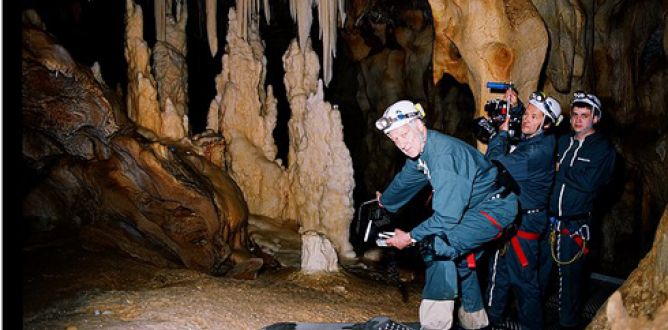Cave of Forgotten Dreams Parent Guide
This unfortunate cinematography is the only real disappointment in this otherwise excellent production.
Parent Movie Review
In 1994 a trio of scientists (Eliette Brunel-Deschamps, Christian Hillaire, and Jean-Marie Chauvet) were exploring the archeologically rich region above the Ardèche River in southern France. All avid speleologists, the group was hunting for caves and found a small opening in the limestone cliffs that looked promising. Although each had made discoveries before, what they found as they dug their way into the crevice and larger chamber beyond was about to become known as one of the most significant prehistoric art sites ever uncovered.
Since its initial discovery, the scientific community has protected the site in order to preserve the treasure trove of Paleolithic wonders within. Consequently, few eyes have beheld Chauvet Cave’s pristine rock paintings, fossilized animal bones, preserved prints and natural geological formations. That is until the French Department of Culture granted permission to moviemaker Werner Herzog and his small camera crew to film the ancient depths, and share its beauty and mystery with the public at large.
For both the serious student and the casually curious observer, Cave of Forgotten Dreams offers a unique opportunity to go where few have gone in the last 32,000 years. With Herzog providing narration and various experts (including Jean-Michel Geneste, Dominique Baffier and Jean Clottes) acting as tour guides, viewers can follow the single-file path that leads through the caverns, gazing at the art and listening to a detailed interpretation of images and artifacts.
Like an opened time capsule, these nearly perfectly preserved drawings form a picture of the prehistoric world. Life-like images of horses, bison, cave bears, rhinos, mammoths, lions and panthers depict many animals that have been extinct for thousands of years. Handprints, footsteps and a single human figure reassure of man’s presence. And the detailed and complex execution of the renderings speaks volumes about the intelligence and skill of these early artisans.
In order to do justice to the paintings that use the natural typography of the walls to enhance a sense of shape and movement, Herzog has filmed this documentary in 3D. He also sways his battery-powered lights across the surfaces, imitating the flickering torchlight most likely used when looking at the drawings when they were originally created. This effect is amazing, as the etched creatures seem to come to life. It also enriches the experience for modern-day audiences.
However, the 3D technique used on the rest of his footage is wasted on talking heads, and anything but enhancing during dizzying drops down rockshafts and skimming over landscapes. While I know I am more prone to motion sickness than many, I still suspect few will appreciate this hand-held style (they could have used a steady cam), or the artistic decision to trudge alongside a group of mountain climbers who have been shot upside down.
This unfortunate cinematography is the only real disappointment in this otherwise excellent production. The rest feels like a visit to a cathedral where privileged scientific pilgrims reverently explain their research and conclusions. Herzog interviews specialists from other sites in the region too, who add information they have gained from findings such as musical instruments carved from bird bones and naked female sculptures that closely resemble the figure sketched in the Chauvet Cave. This combined insight brings a shaft of light into a dark abyss of history that has been lost in obscurity for millennia.
Theatrical Release Date: 25 March 2011 Limited
Directed by Werner Herzog . Starring Werner Herzog, Dominique Baffier, Jean Clottes. Running time: 90 minutes. Theatrical release September 2, 2011. Updated July 17, 2017
Cave of Forgotten Dreams
Rating & Content Info
Why is Cave of Forgotten Dreams rated G? Cave of Forgotten Dreams is rated G by the MPAA
Violence: A scientist explains and demonstrates the use of ancient weapons, like spears.
Sexual Content: The naked torso of female sculptures are shown and discussed. The distinctively male characteristics of a drawn animal are pointed out.
Language: None Noted.
Alcohol / Drug Use: None Noted.
Page last updated July 17, 2017
Cave of Forgotten Dreams Parents' Guide
For more information about this incredible Paleolithic discovery see:
http://www.culture.gouv.fr/culture/arcnat/chauvet/en/
http://www.bradshawfoundation.com/chauvet/chauvet_cave_art.php
Home Video
The most recent home video release of Cave of Forgotten Dreams movie is November 29, 2011. Here are some details…
Home Video Notes: Cave of Forgotten Dreams
Release Date: 29 November 2011
Cave of Forgotten Dreams releases to home video on November 29, 2011. The 2-Disc Blu-ray set includes a 3D version of the film.
Related home video titles:
Werner Herzog also directed the Antarctica documentary Encounters at the End of the World. Prehistoric life is fictionally depicted in the movies Ice Age and 10,000 BC (although the rock paintings explored in Cave of Forgotten Dreams are believed to date back to 30,000 BC).

